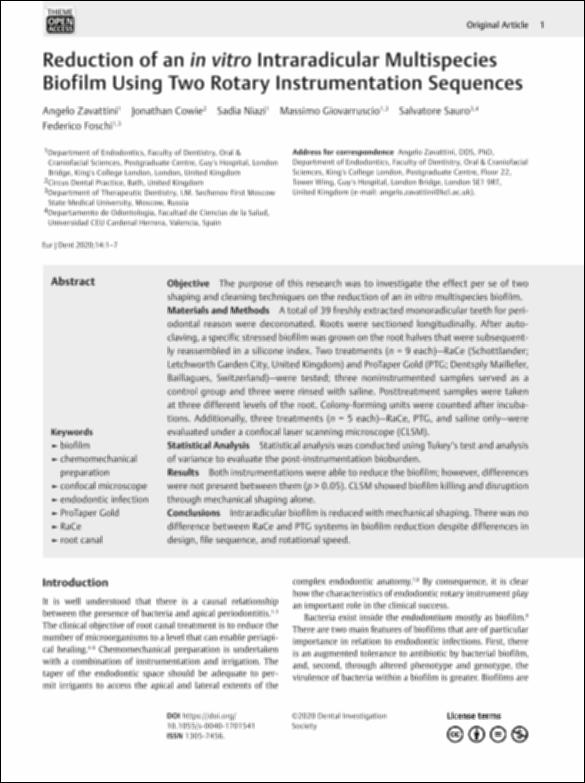Por favor, use este identificador para citar o enlazar este ítem:
http://hdl.handle.net/10637/12870Reduction of an in vitro intraradicular multispecies biofilm using two rotary instrumentation sequences
| Título : | Reduction of an in vitro intraradicular multispecies biofilm using two rotary instrumentation sequences |
| Autor : | Zavattini, Angelo Cowie, Jonathan Niazi, Sadia Giovarruscio, Massimo Sauro, Salvatore. Foschi, Federico |
| Materias: | Materiales biomédicos.; Biomedical materials.; Teeth - Roots - Planing.; Endodontics.; Dental materials.; Materiales dentales.; Endodoncia.; Dientes - Cavidades - Preparación. |
| Editorial : | Dental Investigation Society. |
| Citación : | Zavattini, A., Cowie, J., Niazi, S., Giovarruscio, M., Sauro, S. & Foschi, F. (2020). Reduction of an in vitro intraradicular multispecies biofilm using two rotary instrumentation sequences. European Journal of Dentistry, vol. 14, n. 1 (04 feb.), pp. 1-7. DOI: https://doi.org/10.1055/s-0040-1701541 |
| Resumen : | Objective The purpose of this research was to investigate the effect per se of two shaping and cleaning techniques on the reduction of an in vitro multispecies biofilm. Materials and Methods A total of 39 freshly extracted monoradicular teeth for periodontal reason were decoronated. Roots were sectioned longitudinally. After autoclaving, a specific stressed biofilm was grown on the root halves that were subsequently reassembled in a silicone index. Two treatments (n = 9 each)—RaCe (Schottlander; Letchworth Garden City, United Kingdom) and ProTaper Gold (PTG; Dentsply Maillefer, Baillagues, Switzerland)—were tested; three noninstrumented samples served as a control group and three were rinsed with saline. Posttreatment samples were taken at three different levels of the root. Colony-forming units were counted after incubations. Additionally, three treatments (n = 5 each)—RaCe, PTG, and saline only—were evaluated under a confocal laser scanning microscope (CLSM). Statistical Analysis Statistical analysis was conducted using Tukey’s test and analysis of variance to evaluate the post-instrumentation bioburden. Results Both instrumentations were able to reduce the biofilm; however, differences were not present between them (p > 0.05). CLSM showed biofilm killing and disruption through mechanical shaping alone. Conclusions Intraradicular biofilm is reduced with mechanical shaping. There was no difference between RaCe and PTG systems in biofilm reduction despite differences in design, file sequence, and rotational speed. |
| Descripción : | Este artículo se encuentra disponible en la siguiente URL: https://www.thieme-connect.com/products/ejournals/pdf/10.1055/s-0040-1701541.pdf |
| URI : | http://hdl.handle.net/10637/12870 |
| Derechos: | http://creativecommons.org/licenses/by-nc-sa/4.0/deed.es |
| ISSN : | 1305-7456. 1305-7464 (Electrónico). |
| Fecha de publicación : | 4-feb-2020 |
| Centro : | Universidad Cardenal Herrera-CEU |
| Aparece en las colecciones: | Dpto. Odontología |
Los ítems de DSpace están protegidos por copyright, con todos los derechos reservados, a menos que se indique lo contrario.


